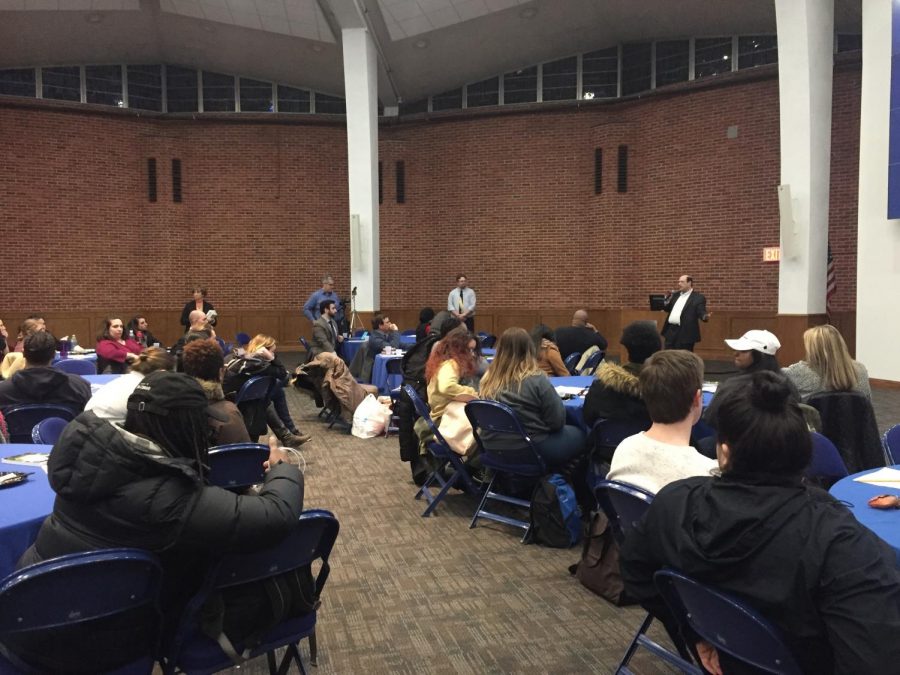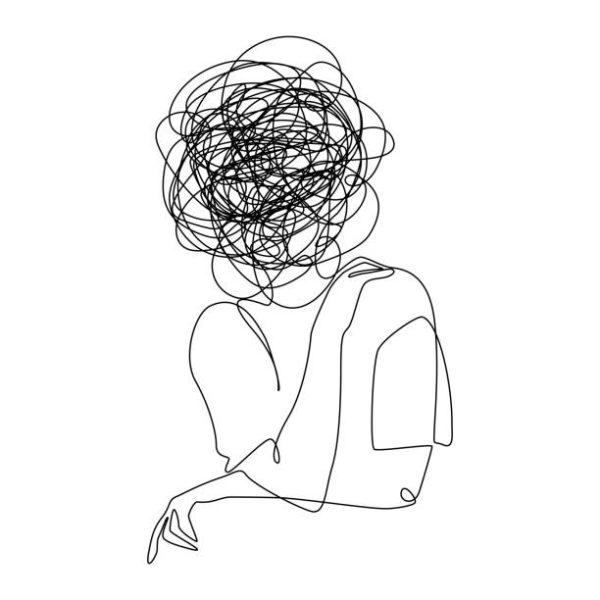Understanding Prejudice with the Help of Psychology and Political Art
Prejudice is all around us whether we like it or not but in order to break its barriers, we must understand how it is formed. That’s when Dr. Mark Sirkin steps in. He teaches students about prejudice in the form of political art and takes us back to how it is started.
Mark Sirkin is the Associate Dean in the School of Social and Behavioral Sciences as well as the director and associate professor in mental health counseling program. He studied psychology at Boston University when he became curious about people in cults and their belief in religion. He has been studying psychology for 30 years and this is his sixth year in Mercy College.
Sirkin led the lecture on March 5 with about 30 students to teach them about prejudice in the form of art. But that’s not the only message that he wanted to convey to the students, he also wanted the students to have an understanding of why people become prejudice to a certain group of individuals by involving psychology and one’s environment.
“I want them to understand we can all be psychologically manipulated. Even good people can do bad things and vice versa. To showcase the black and white, what’s right and wrong and to be able to use their thinking skills,” Sirkin explains.
But in order to get in the mindset of those who are prejudice among a certain group of people, Sirkin says most of what occurs in the adulthood phase has a lot to do with the way one was raised.
As an infant, a person is attached to his or her mother at all times. Whatever she does, the child mimics because they are the only source that we are connected to. In order to understand the people around us, children observe what their mother does and memorizes it in order to do the same thing. This stage has a lot to do with the environment an infant is raised in.
Stephen Bodie, senior majoring in International Relations and Diplomacy, believes that if a mother isn’t in the picture, the kid is bound to go in a different direction. He also believes that the media is to blame for the disrespect of minorities and what is shown in television influences the way one acts toward a certain group of individuals.
“What they see on television or how they saw their father treat their mother can also have an affect on how they treat other women, which can make them become sexist,” states Bodie.
Sirkin identified psychologists that have made a big impact on the way a human mind works and contributes to how mothers are an important factor in their children’s lives. Sigmund Freud’s theory of ego and superego began when studied babies in order to understand an infant’s mind at that age and try to compare it with the mind of an adult. He believes that the ego protects the person from psychological events and that babies have a fragile ego. A baby already has a defense mechanism in order to survive which is that they already feel cold and hunger at that stage in their lives. Once they have that defense mechanism, they learn towards their mom for idealization and identification.
They go to their mom for food or for warmth because that’s the person that they idealize. They also identify with her, when the mom does an action like cry, the baby already has a sense of identification because they cry too. But as they get older, they start to branch out and question everyone’s action.
Most people try to understand why sexism is built if a child idolizes their mom at a young age, since the moms are the ones who have a lot to say about who they will become in the future. When it comes to sexism, Sirkin says that it dates back to the beginning of time. Men were taught to always be the dominant one in the gender because of the way they are built. Men are part of the higher group so they put on the role of being protective, which makes them feel that they are in charge of the lower group which are the females.
“Men grow up to think they are powerful but women have the power because they can have children and men can’t,” says Sirkin.
Lianna Negron, majoring in Exercise Science and Clinical Track, was raised in a strong minded family to spread kindness to all the people regardless of the hate and differences going on in the world. She understands that its the family and the environment that makes up a person. She believes that by not growing up with their mother, they might turn into someone that is angry with the world.
“The ideology that they grew up in, influence the way they are. By not having their mother with them, creates anger build up inside them and they don’t have someone to idolize,” says Negron.
As the child gets older they start to look at other people and compare it to how their mothers taught them or acted upon a situation. If the other person doesn’t mimic what their mom did then they start to question themselves. That’s the beginning of a different stage, now they aren’t relying on their mother but they are observing the world around them and the people in it. Their mind starts to go on a spiral and makes the person feel confused.
In order to get the students to learn how the mind plays games with a person, Sirkin had the students identify an image on the screen. One side of the picture was black while the other was white. It was confusing to some because in the picture, there was two images. Only some students saw both while the others saw only one of the other. Both images had one color either black or white and they both collided with each other which is why it was hard for some students to see both images in one.
“Some people think it’s motivated. A person is a thing so they tend to see one. Some shapes are easier to see then others, some people see the dark figure then white because that’s how people process black and white,” explains Sirkin.
Although the mind does play games with a person, it is mostly based on the people you are around with and who you start to interact with. If you are with someone who does bad choices, most likely you will do them too. At this stage you are no longer idealizing your mom but the people around you. It’s start to collide because of the way you were raised, the people you are around with and the mind that plays games with you. Bodie believes that the most important phase is the way someone is raised.
“It all comes down to what that person has learned. It’s easy to have a group to influence an individual, depends who you were born and raised by and with. They need to change and distance themselves if there is bad influence around them,” Bodie explains.
Once they pass the idealization and identification stage, they move on to a phase called projection which is ‘something that happening in you that you can’t accept it and you launch it out.’ Every bad feeling and thought you have, are projected onto the enemy which is anyone who doesn’t agree with what you have been taught. A child is hopeless without it’s mother and makes friends that can protect them. As we grow older, our childish fears become reality.
Everyone has a ‘self’ and a ‘shadow.’ In the first half of our lives, we tend to focus on our ‘self,’ that includes personal expression and regulating and integrating other aspects of ourselves. It focuses on knowing who we are.While the ‘shadow’ is a part within us that manifest itself. It’s the parts that we want to disown and not show to the rest of the world. We concentrate in knowing our shadow. We try to deny the shadow because it is a hidden side of ourselves that we don’t want to launch out.
“People tend to focus on ourselves and the shadow is something holding us back. The shadow can become evil. As you get older everyone has a good and evil but not dealing with it, it’s a formula to come back to haunt you,” explains Sirkin.
But it’s not only the environment that influences the way someone thinks but we also learn it in the form of art. In order to showcase how art can change the way someone may think, Sirkin showed the students many varies posters, mostly political to give them an idea on how posters can influence a person and how it can create prejudice. Posters such as Rosie the Riveter which symbolizes the strength of the females during WWII was shown. This poster encourages females to take charge and be strong.
“I think it gets into your mind. If they can see an images, it’s powerful in a way. Art reinforces the hate,” says Sirkin.
Bodie agreed with Sikin, posters can influence the way one thinks and acts.
“Posters reinforce what they believe people have to look outside of the box from what they learned. Stereotypes also comes into play,” Bodie says.
Sirkin also showed the students a poster of Adolf Hitler being held as the father figure and being idolized. This poster encourages people to take a stand with Hitler because he is the leader of the country. Another poster was against interracial couple, claiming that it’s okay to kill, rape and even eat people but it’s not okay to be in a interracial relationship. This poster was trying to influence the viewers that by being with someone who isn’t the same color as the other person, they’ve already committed a terrible crime. Racist people tend to think that people who don’t act or look like them are outsiders therefore creating them us enemies. In other words, if you are not one of us than you are one of them.
Bodie believes that prejudice is a factor to racism and sexism but not the cause. Prejudice pushes you to become that, it doesn’t automatically make you that way because you have the environment and the shadow within you that makes you think the way you do.
“Having prejudice against someone, you already have a stereotype building blocks to create sexism and racism,” shares Bodie.
The mind thinks on its own and thinks in all good and bad. There is no such thing as evil because the mind is trained to look for the grey. The evil or the bad within someone comes out when they feel threatened or wronged. Those people treat others like objects which lead to racism and sexism, by treating other like objects they are indicating that they are more powerful than them. Even when they see a good light within the minor groups, they will still see the negative in them. We already have an idea of what evil is and we hold on to it. That’s the next phase, the projection identification which is where we launch out to our enemy and turn into evil. They start to think in a fight or flight defense and some choose one or the other which can identify if they choose to do an evil act or not.
“Prejudice is a leading cause because if you think unfairly of a group of people then you hate them. If you don’t have a good mindset then they can manipulate them,” explains Negron.
Sikin gave an example of how someone can turn evil based on their environment. He used Patty Hearst, who was kidnapped and brainwashed into thinking and acting in a terrible way. In a way it can be described as Stockholm Syndrome, which is when people who have been captured identify with their kidnappers and turn into them.
“People influence other people all the time. Therapy helps remove those people in those situation through stop techniques,” says Sirkin.
People who have evil thoughts or do evil acts, are not capable of knowing that what they are doing is wrong. In their mind they believe they are doing right because in their childhood no one was there to let them know what was right and wrong. They know that they are doing evil acts but are not aware that what they are doing is a sense of evil, therefore continue to do it regardless. The reason is because their emotion trumps the reason.
“Treating people like objects leads to hate. They don’t hate a certain group of people, they hate what those people stand for. It’s hard to hate someone you know very well,” states Sirkin.
Sirkin continues to explain his idea on why people feel prejudice against a group of people. He wants the students to understand that the mind creates an interpretation of someone because of what they believe. If the other person believes in a different idea, then they must be wrong because it’s not what they are thinking. In other words, if you don’t agree to what the other person believes then your mind signals you to put them in the wrong.
“Every group wants to feel cohesive and special and idolization. It’s very environmental, the outside world is not like them. All the bad things are in the other group, not on them,” explains Sirkin.
Bodie believes that racism is taught and no one is born racist. “I don’t think someone is purely evil, it has to do about environment. Reinforcing it with positive thoughts, can change the person around.”
The big question is how can prejudice be stopped? Sirkin has an idea on how we can start making the change. He believes that we need challenges and goals that include people by started with the environment. Getting to know one another and understanding each other can also help.
“Make a big project to pull in people together. Work together to know each other, once we get to know somebody it will hard to prejudice.We need to refocus on unity,” Sirkin advises.
Bodie disagrees. He believes that by not talking about differences we can live and enjoy life.
“When you don’t talk about it, it won’t be brought up. When other media outlets puts their own spin in it, they create argument,” Bodies explains.
But even though everyone has many ideas on how to end prejudice, one thing is for certain. Differences must be put aside and helping each other is the first step. By doing so, you are helping yourself and the people around you. In order to do that you must be kind and think in a mindset that everyone is born to be equal.
“Treat people with equality, it’s not hard to be kind,” Bodie concludes.

The name is Loaiza, Andrea Loaiza. She is currently a junior in Mercy College on her way to getting her bachelors in Media and Journalism. She...








